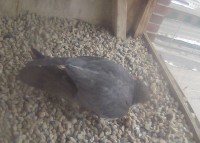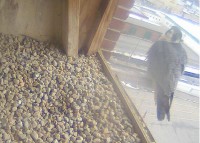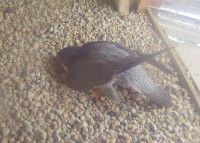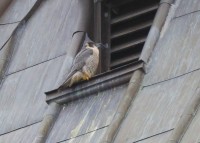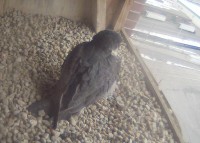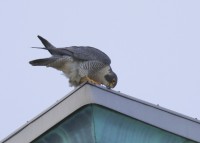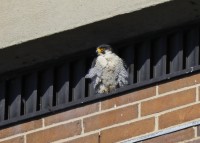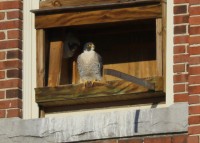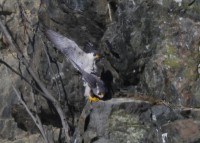Lawrence Peregrines: mutual ledge display
March 25, 2018 in In the Nest Box, Peregrine Falcons Eastern Massachusetts, Peregrine Falcons Massachusetts
 Observing the peregrines through the New Balance Falcon Cam under mostly cloudy skies, wind from NW at 17MPH with stronger gusts, and temp in mid-thirties.
Observing the peregrines through the New Balance Falcon Cam under mostly cloudy skies, wind from NW at 17MPH with stronger gusts, and temp in mid-thirties.
An awesome opportunity to observe as the male flew into the nest box and walked to the back near and below the web cam. His leg bands were visible and allowed for positive ID. Minutes later, the female landed on the perch pole, then hopped her way inside the nest box. They looked at each other for a moment and then proceeded to engage in normal courtship behavior known as mutual ledge display, which included touching their bills together many times….not often seen, and a magnificent sight to behold!
Mutual Ledge Display: Often this is precipitated by a male or female ledge display. The other bird joins the first on the ledge and both bow and ee-chup over the scrape, sometimes touching bills. This can also happen outside the eyrie.
Billing: Billing is often seen during the longer mutual ledge displays and occasionally when the pair is perching very close together. Billing involves twisting the head sideway especially by the female, and nibbling between beaks. The female’s head is usually very low with her beak directed upward, while the male faces downward. If billing occurs during a mutual ledge display, the normally loud Eechip vocalization tends to diminish toward Peeping and quiet female Chupping-incomplete variations of the Eechip sound unit.
Literature Cited:
Cade, T. J., J. H. Enderson and J. Linthicum. 1996a. Guide to Management of Peregrine Falcons at the eyrie. Boise, ID: The Peregrine Fund, Inc. (Excerpt: Linthicum, Janet. Observing Breeding Behavior)
Wrege, P. H. and T. J. Cade. 1977. Courtship behavior of large falcons in captivity. Raptor Res. no. 11:1-46.
